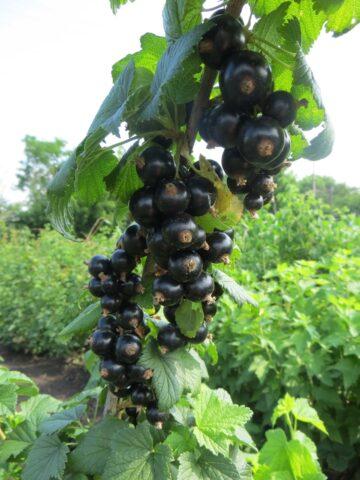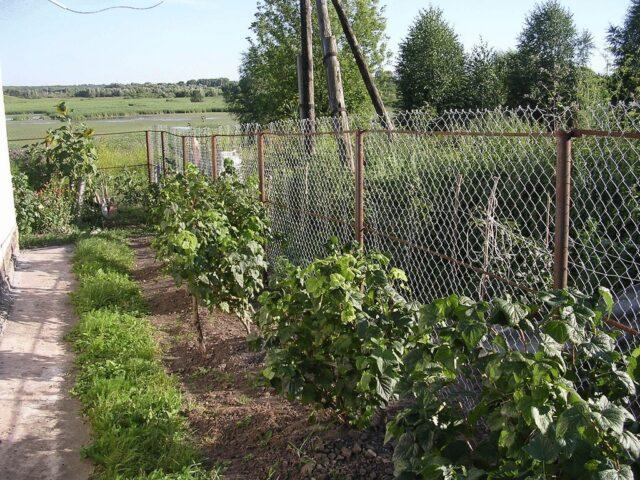Content
Big Ben currant is a new variety of Scottish selection. It produces very sweet and large berries, the yield reaches 4.5 kg per bush. Characterized by low winter hardiness. Therefore, when growing even in the middle zone, you will need to create a good shelter.
History of selection
Big Ben is a blackcurrant variety that was obtained relatively recently. It was released in Scotland (UK) in 2008. It has not yet been included in the Russian register of breeding achievements. But the culture has already become known to many summer residents.
The variety is valued for its very high yield - more than 4 kg per bush, as well as for the pleasant, dessert taste of the berries. It can be grown in different regions of Russia, including in the middle zone, in the North-West in the Volga region and southern regions.
Description of the Big Ben currant variety with photo
The description of the Big Ben currant variety provides the main characteristics - the appearance of the bush, size, color of the berries and others.This will help you get to know the culture better.
Bush
The bush produces vertical shoots reaching a height of 1.5 m. The leaves of the Big Ben currant are broad-bladed and have a smooth surface on the outside. The edges are curved down.
The branches may bend during growth, causing the crown to partly spread out. Therefore, Big Ben currant bushes need more space than a number of other varieties. On the other hand, they are easier to pick berries from. The shoots are quite strong and elastic. They do not break even under gusts of wind and can withstand the weight of the harvest well.
The bushes grow very quickly. In the first two years they reach the required height, and from the third they begin to bear fruit. Moreover, productivity is maintained for 10-12 years.
Flowers up to 1 cm in diameter are pink or purple, collected in drooping racemes (1-2 in each node). Inflorescences appear in May and June, then fruits begin to form towards mid-summer. The brushes are up to 8 cm long, the first one grows at a height of 10-15 cm from the ground surface.
Berries
The fruits are black, glossy, and attractive in appearance. The berries are large, average weight 2.3 g. The shape is regular, spherical. They can be eaten fresh and kept in the refrigerator for up to one week. Also, Big Ben currant fruits are suitable for canning and making jam.
Characteristics of the variety
Among the characteristics of the Big Ben variety, summer residents are most interested in yield, taste of berries and winter hardiness. The main parameters are described below.
Taste qualities
The taste of Big Ben berries is very sweet, dessert, with a pronounced aroma. The pulp is juicy, but not watery. These fruits are especially good to eat fresh. To preserve the nutrients as much as possible, it is recommended to freeze and store in the freezer for up to six months.
Ripening time
Big Ben currant belongs to the mid-late crops. The fruits begin to form in mid-summer. They sing together, which makes harvesting easier.

Ripening begins in the first half of August
Productivity
The yield of the crop is very high - up to 4.5 kg per bush. This indicator can be achieved when grown in mild climates, for example, in the south or in the Black Earth Region. Also, for high yields it is necessary to provide good care - watering, fertilizing. It is equally important to choose the right place - Big Ben blackcurrant grows well in loose, fertile soils.
Frost resistance
The frost resistance of this crop is low - in open ground it can withstand up to -17 degrees. In most parts of Russia, winters are more severe. Even in the middle zone, temperatures often drop below -20. Therefore, it is recommended to cover the bushes for the winter (especially young seedlings). In the conditions of the Urals, Siberia, and northern regions, growing Big Ben currants is quite risky. You will need to create a reliable protective shelter or even plant them in greenhouses.
Pollinators of Big Ben currant
The Big Ben blackcurrant variety is self-fertile and does not require pollinators. To prolong fruiting and, accordingly, increase productivity, the originator recommends planting the Ben Tirran variety on the site. It is not so easy to get it - seedlings are sold in the UK and neighboring countries.
Disease resistance
The immunity of the Big Ben variety is quite good. It rarely suffers from diseases, especially if proper care is provided and watering is maintained. It is also necessary to take care of preventive treatments against fungal infections (they are done in early spring).
In summer, the bushes are periodically monitored. Insects are destroyed using folk remedies or insecticides. It is also recommended to monitor birds that are actively pecking at the berries. To do this, install a scarecrow and use special repellers.
Advantages and disadvantages
The Big Ben variety has many advantages. This is a high-yielding crop that produces truly tasty, sweet berries. Winter hardiness is low, so in the fall it is necessary to take care of shelter.

The berries are large and very sweet
Pros:
- pleasant taste;
- high productivity;
- early and long-term fruiting;
- satisfactory drought resistance;
- the variety is resistant to various types of rot and spotting;
- the bushes are moderately spreading.
Minuses:
- winter hardiness is low;
- The shoots are long, so they need to be tied up.
Features of growing Big Ben currants
To get a good harvest of black currants, the Big Ben variety must be properly cared for. The culture is responsive to regular watering and fertilization.
Planting Big Ben currants
To plant Big Ben currants, choose a well-lit, dry place away from lowlands where rain and melt water accumulate. The soil should be loose and fertile; loam with a neutral or slightly acidic pH of 5.5 to 7.0 is optimal.
Seedlings can be planted both in spring (March, early April) and autumn (first half of October). They usually go on sale between November and early April. Therefore, planting is planned more often in early spring than in autumn. During this time, the Big Ben currant has time to take root and prepare for the first winter.
Soil preparation should begin in the fall. The soil is dug up onto the bayonet of a shovel and compost or humus is added - a bucket per square meter.If the soil is too dense and contains a lot of clay, you must add sawdust or sand in an amount of 2-3 kg to the same area.
When buying a seedling, you need to pay attention to its appearance:
- the roots are well developed, there are no signs of disease;
- there are 3-4 healthy shoots of a light gray shade;
- kidneys without damage;
- the bark is intact, without scratches.
Big Ben currant seedlings are sold in pots (closed root system), so they do not need special preparation. The day before planting, water them well to form an earthen ball.
The holes are dug in advance according to the following scheme:
- depth 60 cm;
- width 50-60 cm;
- minimum interval 1.8 m.
The sequence of actions when planting Big Ben blackcurrant is as follows:
- Dig a hole and place a layer of small stones at the bottom.
- Transfer the seedling using the transshipment method, preserving as much of the soil as possible.
- Place it in the center at an angle of 45 degrees to the ground.
- Dig in with soil and tamp down so that the root collar goes 8-10 cm into the ground. There should be at least 5 buds left in the soil - they will produce basal shoots.
- Water with settled water (1-2 buckets).
- Trim all shoots, leaving 2-3 buds on each.
- Lay out hay, straw, peat or other mulch.

It is advisable to plant along the fence so that the bushes are protected from strong winds
Caring for Big Ben currants
To get a good harvest, Big Ben currants need to be looked after quite well. In the first months, watering is done every week, then water is given as needed, spending up to three buckets on an adult bush. It is necessary to ensure that the soil does not dry out, but at the same time is not too wet. The drought resistance of the variety is relatively good, but if there is a lack of moisture, the fruits will be small and not so tasty.
It is very important to fertilize regularly. In the spring, nitrogen compounds are given - urea, ammonium nitrate, mullein. During the formation of buds and ovaries, superphosphate and potassium sulfate are given. After harvesting, you can feed with an infusion of wood ash, but under no circumstances give nitrogen.
The soil is periodically loosened and weeded. To keep the soil moist, maintain a layer of mulch at all times and replace it periodically.
Since the Big Ben blackcurrant produces rather tall shoots that deviate to the sides, the bush must be tied up. To do this, install pegs, for example, wooden or plastic, around the perimeter of the bush. The branches are tied to them with a strong rope.

Thanks to regular feeding, the bushes will produce up to 4.5 kg of tasty berries
Another important point is shelter for the winter. At the end of October - beginning of November, lay a high layer of mulch - at least 10 cm in height, prune and tie 2-3 branches together. Then they are carefully bent to the ground and fixed with wooden boards. Cover the top with dry, loose soil. When snow falls, you need to make sure that it lies in a layer of at least 20 cm.
Conclusion
Currant Big Ben is a variety with very sweet, large berries. Due to its high yield, it is suitable for cultivation on private farms and for sale. He is high maintenance. It is especially important to take care of the garter and winter shelter.
Reviews from gardeners about Big Ben currants








